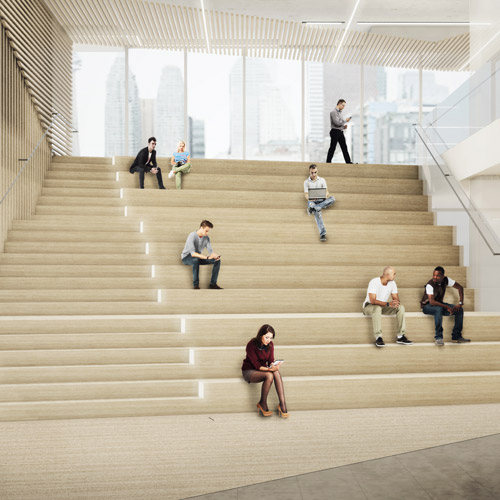When high school students study for the admission test that could help get them into college—the ACT—the focus isn’t just on math or verbal skills. Students must prepare for multiple subjects. Ultimately, it’s the sum of their knowledge that matters.
In that sense, the executive team that manages the administrative offices of the test provider, ACT, Inc., isn’t all that different from the students. Throughout the past decade, the company has transformed its long-established office campus in Iowa City, Iowa, for both pragmatic and altruistic reasons—to increase building-use efficiency, to become more sustainable, and to reflect the changing face of education.
The 360-acre campus includes a LEED Platinum-certified building, as well as many other retrofits to the rest of its buildings to offer definitive energy efficiencies. However, if you say “sustainability” anywhere near pro-environment Iowa City, home to the University of Iowa, you’ll soon find that the term encompasses much more.
ACT’s director of real estate and facilities management, Jeff Stabenow, says the company’s recent sustainable real estate program took the efforts and creativity of several team members, including Anne Schaefer, senior program manager; Brad Spillman, senior facilities manager; Chris Wilson, energy specialist; and Paige Butterfield, senior facilities manager.
Even with no new buildings constructed on campus in seven years, the upgrades the team provided created a new environment. The work started with implementation of a wholesale upgrade of lighting from incandescent bulbs to compact fluorescent, and finally, LED bulbs. The campus also makes use of solar and geothermal energy in an effort that moves ACT closer to achieving its goal of capturing 100 percent of stormwater.
The newest building on campus, constructed in 2009, was the first to achieve LEED Platinum status in the state.
“It’s a 10,000-square-foot data center that uses geothermal and free cooling systems to dissipate heat produced by the servers,” Stabenow says.
For the 1,100 people who work in ACT’s Iowa City office (there are additional leased offices throughout the world), several of the campus changes provide an optimally healthy workplace.
“The Tyler building was the main operational building for many years,” Schaefer says. “We renovated it about 12 months ago to class-A office space.”
Changes to the office included more collaborative team spaces, as well as individual workstations with adjustable-height desks that allow team members to stand while they work. Schaefer estimates that about 20 percent of the renovation was dedicated to the creation of an employee wellness center.
A walk down a curved hallway in the Tyler Building gives visitors an idea of this healthier environment. Red walls, ceiling, and flooring can’t help but energize employees heading to the fitness center, while words such as “challenge,” “knowledge,” “enjoy,” “ideas,” “transform,” “gather,” and “breathe” double as wall decoration and inspiration.
3,500
pounds of waste composted per month
4.5
tons of waste diverted from landfills per month
1.65
miles of campus walking trails
3,093
new LED light fixtures
40,500
pounds of carpet recycled
For ACT, changing the lighting throughout campus means more than installing a few LED light bulbs. Recently, the company installed new controls to monitor daylight at the Davidsen Building. These controls cut artificial lighting during sunny periods, and have already reduced electrical usage by 15 percent in the (darker) winter months of 2016.
The four buildings that make up the core of the campus are on an energy management system to monitor gas, electric, and water consumption.
“It gives us live data that allows us to see spikes,” Wilson says. “If a piece of equipment is failing, we can troubleshoot and fine tune. This is particularly helpful in times of high demand.” Taking it a step further, the campus also has a condensing “summer boiler” that shaves 30 percent of gas use in spring, summer, and fall.
Some of the energy for the ACT campus comes from a raised 10-foot-by-20-foot solar panel array. The power drawn from those panels is used to provide lighting on a campus parking lot. LED lights are rather stingy, so excess energy from the panels is sent to electric-vehicle charging stations in the company parking lot that are free to employees and the public.
Stabenow and his team also place a great deal of emphasis on landscape in the HQ’s Great Plains prairie environment. The grounds and maintenance operations division used native plant species and removed some of the non-native trees to enhance the campus grounds. It’s these measures, along with the incorporation of an Integrated Pest Management program, that serve as an ecosystem-based strategy. Spillman says the irrigation system and best practices defined for the grounds team also helps it move toward that goal of capturing 100 percent of stormwater.
“This complements the campus’ hard-won status as an Audubon Certified Cooperative Sanctuary,” he says.
The grounds also contain a walking trail system, which fits an entire ethos of employee health at ACT. Butterfield works closely with the company’s talent strategies department to develop the onsite wellness center, which in turn supports ACT’s Blue Zone Worksites Project designation for healthy choices engineered into the workplace environment. She’s also heading an effort to implement a workplace-wide recycling effort to achieve zero landfill waste. Each building on campus provides in-office hubs that allow sorting between recyclables, compost, and what can be incinerated off campus.
Zero isn’t a number any student wants to see on their ACT, but it’s a score that sustainable office campuses like to achieve.


